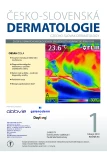-
Medical journals
- Career
Diagnostics of Malignant Melanoma Using Total Body Photography
Authors: J. Šuchmannová; T. Fikrle; K. Pizinger
Authors‘ workplace: Dermatovenerologická klinika FN a LF UK, Plzeň, přednosta prof. MUDr. Karel Pizinger, CSc.
Published in: Čes-slov Derm, 94, 2019, No. 1, p. 18-22
Category: Pharmacologyand Therapy, Clinical Trials
Overview
Early diagnosis of malignant melanoma is the key to good prognosis of the disease. With the increasing incidence of this tumor, the effort to improve the non-invasive examination methods of pigment lesions goes hand in hand. Dermatoscopic examination is already part of the routine practice and a number of workplaces use devices for digital dermatoscopy. However, full-body scanning, followed by changes in pigment lesions over time using computer image analysis, is a relatively new method in our environment. The authors describe the practice of combining both methods, whole-body scanning (mapping) and digital dermatoscopy, which significantly refine the diagnosis and thus reduce the number of excisions performed.
Keywords:
melanoma – total body photography – dermatoscopy
Sources
1. ARGENZIANO, G., CATRICALA, C., ARDIGO, M. et al. Dermatoscopy of patiens with multiple nevi. Improved management recommendations using a comparative diagnostic approach. Arch. Dermatol., 2011, 147, p. 46–49.
2. BERK-KRAUSS, J., POLSKY, D., STEIN, J. A. Mole mapping for management of pigmented skin lesions. Dermatologic clinics, 2017, 35, p. 439–445.
3. CORDORO, K. M., GUPTA, D., FRIEDEN, I. J. et al. Pediatric melanoma: Results of a large cohort study and proposal for modified ABCD detection criteria for children. J. Am. Acad. Dermatol., 2013, 68, p. 913–925.
4. FIKRLE, T., PIZINGER, K. Dermatoscopic differences between atypical melanocytic nevi and thin malignant melanoma. Melanoma Res, 2006, 16, 1, p. 45–50.
5. HAROON, A., SHAFI, S., RAO, B. K. Using reflectance confocal microscopy in skin cancer diagnosis. Dermatol. Clin., 2017, p. 457–464.
6. CHAO, E., MEENAN, C. K. Smartphone-based applications for skin monitoring and melanoma detection. Dermatol.Clin., 2017, p. 551–557.
7. ILYAS, M., COSTELLO, C. M., ZHANG, N., SHARMA, A. The role of the ugly duckling sign in patient education. J. Am. Acad. Dermatol., 2017, 77, p. 1088–1095.
8. KRAJSOVÁ, I., BAUER, J. Melanom-imunoterapie a cílená léčba. Maxdorf Jessenius, 2017, s. 12–13.
9. PIZINGER, K., FIKRLE, T. Importance of dermoscopy in daily clinical practice. Pigment Cell Melanoma Res., 2008, 21, N2, p. 276.
10. SALERNI, G., CARRERA, C., LOVATTO, L. et al. Benefits of total body photography and digital dermatoscopy (“Two-step method of digital follow-up“) in the early diagnosis of melanoma in high-risk patients. J. Am. Acad. Dermatol., 2012, 67, p. e17–e27.
11. TRUONG, A., STRAZZULA, L., MARCH, J. et al. Reduction in nevus biopsis in patients monitored by total body photography. J. Am. Acad. Dermatol., 2016, 75, p. 135–143.e5.
12. WALOCKO, F. M., TEJASVI, T. Teledermatology applications in skin cancer diagnosis. Dermatol.Clin., 2017, p. 559–563.
Labels
Dermatology & STDs Paediatric dermatology & STDs
Article was published inCzech-Slovak Dermatology

2019 Issue 1
Most read in this issue- Invasive Therapy for Chronic Venous Insuficiency
- Perianal Erosion. Minireview.
- Diagnostics of Malignant Melanoma Using Total Body Photography
- Kerion Celsi in a Child: Diagnostics and Treatment Possibilities
Login#ADS_BOTTOM_SCRIPTS#Forgotten passwordEnter the email address that you registered with. We will send you instructions on how to set a new password.
- Career

